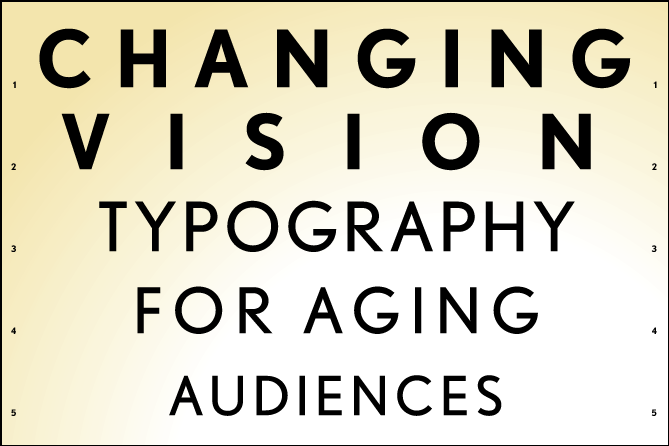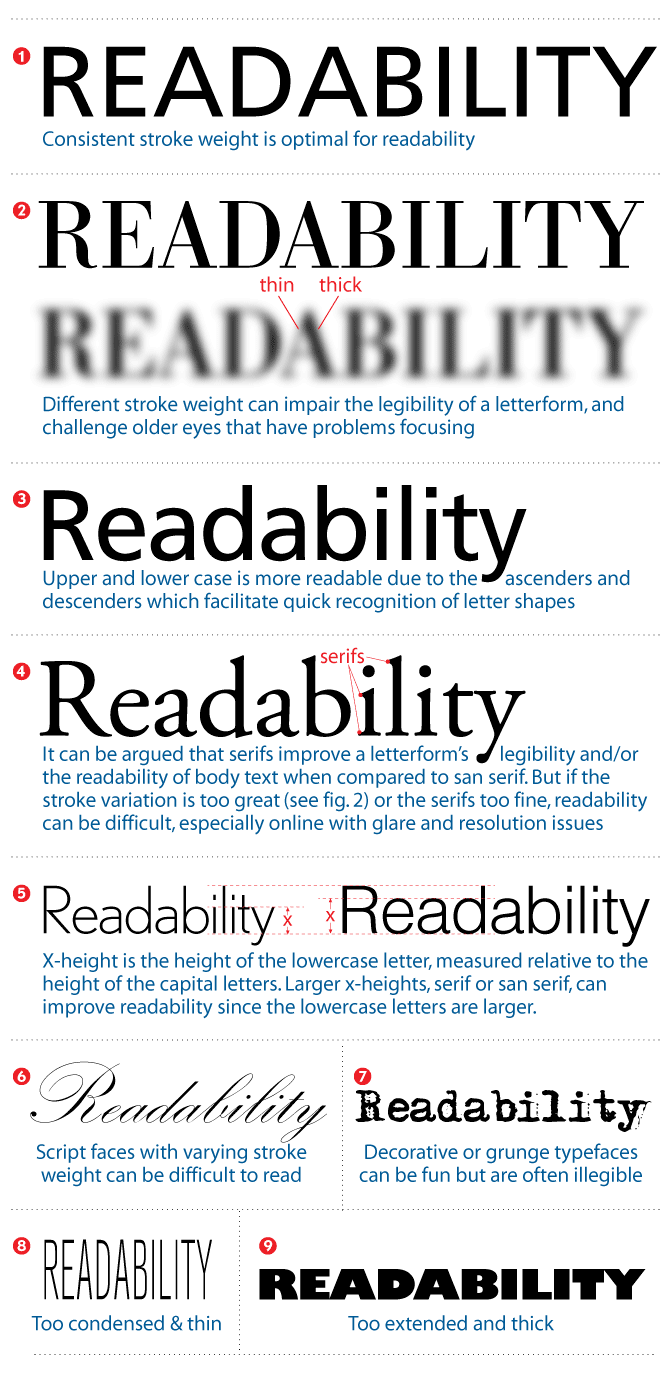
A reader recently responded to my blog post Typeface Choice: Ask yourself Three Questions, by raising an important series of questions on changing vision, information accessibility and type readability for an aging population. The reader works for a nonprofit community support agency that is developing outreach materials for rural seniors, adults with disabilities, caregivers and potential volunteers, and wanted advice on the best typeface to use to “keep the printed conversation going with our target population.”
Choosing a typeface for older eyes
Having designed for years for clients whose audiences include these groups, and with my wife having been executive director of a volunteer center in Québec, communicating effectively with people of different abilities is close to my heart. And having had considerable vision changes in the last 5 years, I have first-hand experience that has informed my design decisions for print and online work.
How do I design for adults with vision challenges?
If your audience includes people in the growing demographic of over 50 years old, what is the best way to clearly communicate with them? The first, most obvious answer is that basic principles of good design and communication need to be followed. These include:
- Readable type size, legible typeface choice, reasonable line lengths
- Good color choices, well-contrasting elements
- Clear and impactful design, good layout and eyepath
The additional specifics of designing for an older population’s eyesight limitations are driven by some of the following conditions:
- Loss of Light Advancing age causes the pupils to shrink, less light enters the eye, causing vision problems in low-light environments.
- Inability to Focus The eye’s lens loses elasticity, becomes less able to focus while reading.
- Vision Field Loss Age-related eye diseases include macular degeneration, which is vision loss in the center of the visual field; glaucoma, which affects side or peripheral vision; cataracts, which cause blurred vision, faded colors and glare; and diabetic retinopathy, in which damaged retinal blood vessels cause blurred vision, severe vision loss and blindness.
These factors will increasingly affect how we design and construct signage in and on stores, museums, parks and other public spaces, hospitals, roads, airports, train stations and subways; and how we design and format type in brochures, direct mail and other print collateral, websites, online and email advertising, and other electronic communications.
Typography basics: even more important for aging eyes
There are some basic rules for type legibility which become even more critical for aging eyes. Think of this as improving information accessibility—the Americans with Disabilities Act (ADA) actually has typeface and design guidelines. Here are a few examples from an ADA spec sheet on specialty signs:
– All letters, numbers and/or symbols shall contrast with their background, either light characters on a dark background or dark characters on a light background. 70% contrast recommended.
– Characters and background shall have a non-glare finish.
– Letterform shall be Gill Sans upper case or other san serif or simple serif letterforms.
– Character Width to Height Ratio between 3:5 and 1:1
– Character Stroke Width to Height Ratio between 1:5 and 1:10
In other words: non-reflective letterforms and symbols should contrast well with their background, the typeface should not be too condensed or too extended, not too thin or thick, or not have thick/thin variation within the structure of the letterforms. A few typefaces that meet these requirements are: (san-serif) Helvetica, Arial, Futura, Gill Sans, Avant Garde, Trebuchet, Verdana, Franklin Gothic, VAG Rounded, Frutiger, and (serif) Garamond, Century Schoolbook, Glypha. Some of these fonts are also standard typefaces on the web, for good reason. A backlit screen presents readability issues that parallel those of older eyes—excessive glare, focusing difficulty, lack of contrast, too much or too little light—so typeface choice is even more critical in electronic display communications materials for aging eyes.
 Various considerations on type readability for aging audiences
Various considerations on type readability for aging audiencesShould I use a serif or san serif typeface?
First of all, there are generally two ways we use type, headline and body text. Headlines are larger, shorter and more quickly and easily read than body text. Since body text is longer and smaller, extra care must be taken when formatting it for aging eyes. Some guidelines: 12-14 point minimum size, with liberal leading (line spacing). Make sure line lengths are no more than 2-1/2 alphabets (65 characters). Flush left, ragged right (instead of justified) allows the eye to find the next line easily. And traditional typographic wisdom holds that serif typefaces are easier to read in long blocks of text. However, some of the above recommendations for ease of readability may seem to conflict with this. There is an ongoing debate on this issue, challenging traditional wisdom, asking whether serif readability is a myth, especially in light of the age of backlit screens surpassing ink-on-paper readership.
Do I choose between good design or readability?
Good design and readability don’t have to be mutually exclusive. Tiny strings of letterspaced type can be attractive design elements, but if they can’t be read by your 50- or 60-year old customer, they’re useless. Instead, the designer must create beauty AND readability, and there are many options to accomplish this while accommodating the needs, physical challenges and comfort level of an aging population. I see these recommendations not as limiting, but an opportunity to be inclusive, to attract more people. Some of the best design is big, bold, beautiful and unmistakably clear, and those qualities make your message appealing to people of all ages.
Resources
Vision Changes and Typography for Aging Audiences: Sources and resources
http://www.aiga.org/typography-and-the-aging-eye/
http://www.terminaldesign.com/fonts/clearviewada-complete-family/
http://www.aph.org/products/aphont/
http://www.fonts.com/content/learning/fyti/situational-typography/designing-for-seniors
http://www.fonts.com/content/learning/fontology/level-4/fine-typography/legibility
http://usabilitynews.org/determining-the-best-online-font-for-older-adults/
http://alexpoole.info/blog/which-are-more-legible-serif-or-sans-serif-typefaces/





